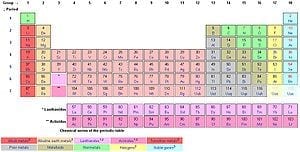Almost all lead is recycled, among the only elements on the periodic table to earn that distinction.
With good reason, mind you: the soft metal is a potent neurotoxic known to impact children’s brain development, among other nasty health effects. Today, nearly all lead is used in batteries (though it was once put into gasoline, leading to widespread contamination, and, in places like Afghanistan, still is.) Most of this dangerous element is now endlessly cycled from battery to battery, thanks to stringent regulations (though enough of it ends up being improperly recycled to constitute one of the world’s worst pollution problems.)
In principle, all metals are infinitely recycleable and could exist in a closed loop system, note the authors of a survey of the metals recycling field published in Science on August 10. There’s a benefit too, because recycling is typically more energy-efficient than mining and refining raw ore for virgin materials. Estimates vary but mining and refining can require as much as 20 times the amount of energy as recycling a given material. Think about it: a vast amount of energy, technology, human labor and time are expended to get various elements out of the ground—and then that element is often discarded after a single use.
Lead is not alone in being recycled, of course. Aluminum, copper, nickel, steel and zinc all boast recycling rates above 50 percent (though not much above 50 percent). The same principles can be usefully applied to other materials, like plastics. After all, these ubiquitous polymers are made from another scarce resource—oil—and many are, in principle, recycleable. Yet, the overall recycling rate for plastics, grouped as a whole, is only 8 percent (as of 2010, per EPA numbers.) Take the case of polypropylene (or #5 plastic if you’re checking the bottom of your food containers). The bulk of this polymer that gets recycled comes from car batteries. It is, in essence, tagging along with the lead. In other cases—water bottles, yogurt cups, you name it—it simply disappears into the nation’s landfills.
Meanwhile, the majority of elements on the periodic table—and we use almost every element on the periodic table for something or other—are also nearly completely unrecycled.
As an example, industrial ecologists Barbara Reck and T.E. Graedel of Yale University compare the fates of nickel versus neodymium. Nickel is ubiquitous, particularly as an alloy for steel. Of the 650,000 metric tons of the silvery-white metal that reached the end of its useful life in one product in 2005, roughly two-thirds were recycled. And that recycled nickel then supplied about one-third of the demand for new nickel-containing products. That means the overall efficiency of human use of nickel approaches 52 percent. Not bad, but there’s room for improvement, given that almost half of all nickel is only used once before it is discarded.
Nearly 16,000 metric tons of neodymium—a so-called rare earth metal—were employed in 2007, mostly for permanent magnets in everything from hybrid cars to wind turbines. Roughly 1,000 metric tons of the element reached the end of its useful life in one product or another—and “little to none of that material is currently being recycled,” the survey authors note. This despite the fact that a “rare earth crisis” stems from China’s near monopoly of the neodymium trade.
via Scientific American – David Biello
The Latest Streaming News: Recycling Reality updated minute-by-minute
Bookmark this page and come back often
Latest NEWS
Latest VIDEO








